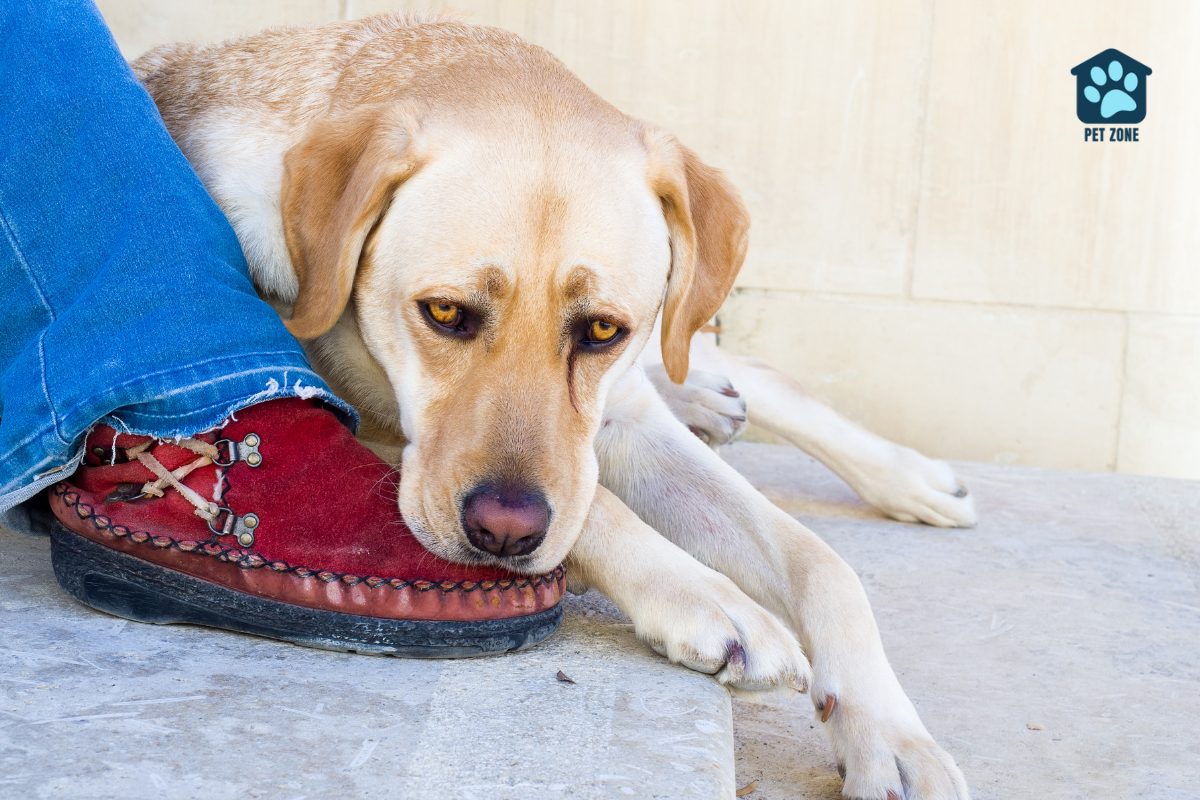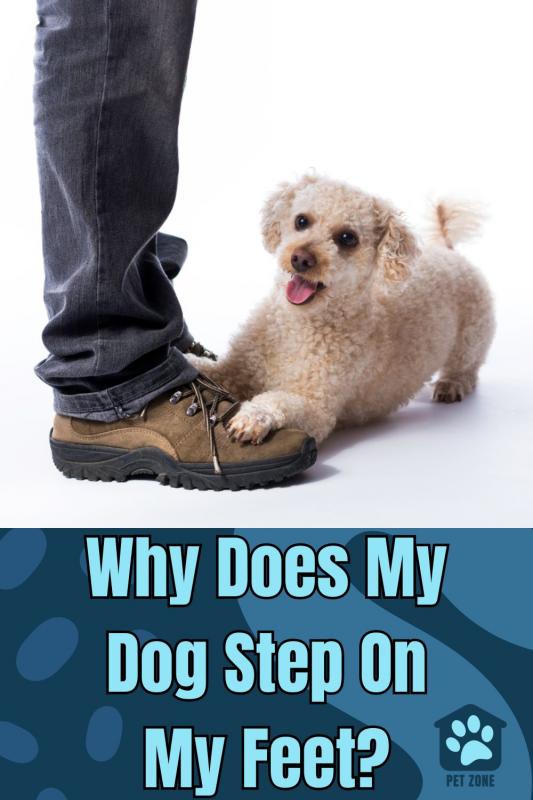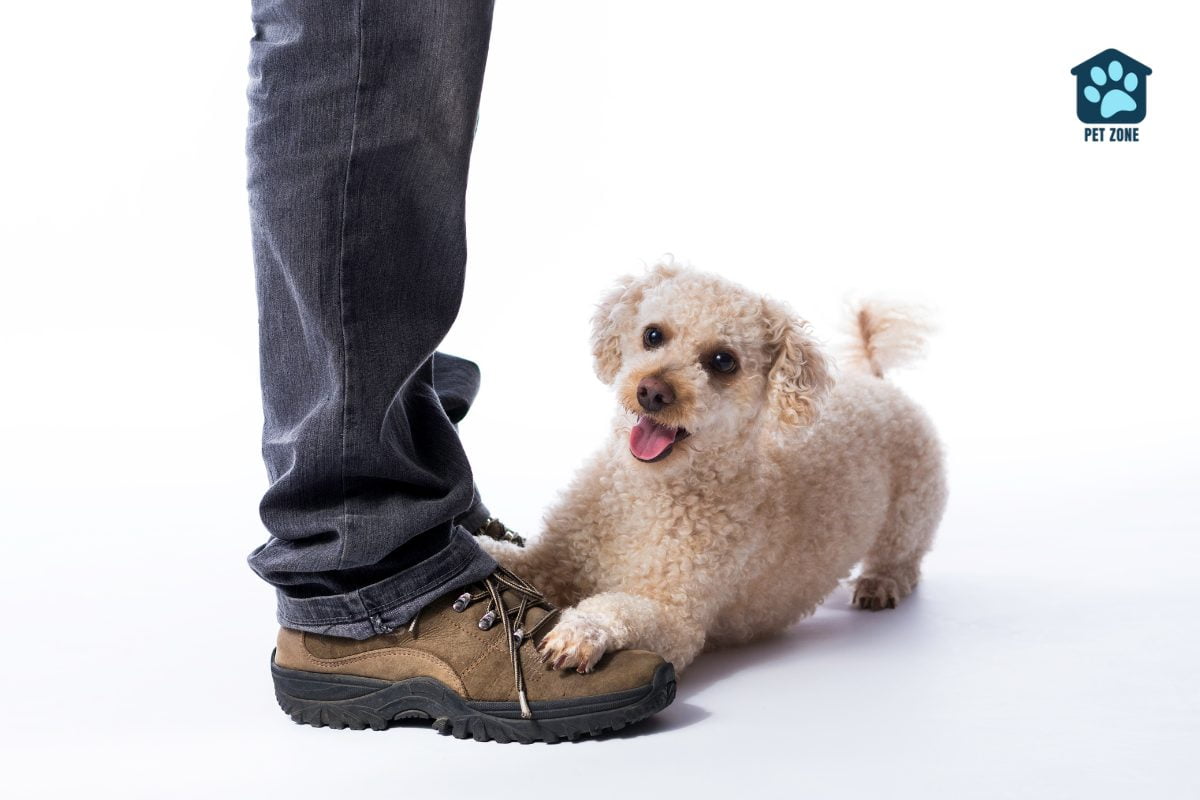Estimated reading time: 11 minutes
Ever wondered why your canine friend treats your feet as his personal resting spot? Many dog owners experience that familiar sensation of a pup planting its paws firmly on their toes or choosing to sit right atop their feet.
Our article dives into the reasons behind this behavior, from seeking protection to expressing dominance, and provides insights into what your pooch might be trying to communicate through this physical action.
With practical advice tailored for dog owners like you, we aim to unravel the mystery of foot-stepping pooches and offer strategies for positive interaction. Ready to discover more about your furry friend’s quirky habits? Keep reading!
Key Takeaways
- Dogs step on your feet for many reasons, including wanting love and to get your attention, showing they care, feeling excited, or displaying protective behavior.
- Some dogs learn to step on feet because it gets them rewards like treats and petting. Other times it might be because they feel anxious or want to show they are the boss.
- If a dog often steps on your feet and acts strange in other ways too, there could be something wrong with their health. Pain or being sick can make a dog act differently.
- You can train your dog not to step on your feet by teaching them commands like “sit” and “stay.” Use kind words, treats, or toys when they do what you ask.
- It’s good to understand why your dog steps on you so that you can help them feel better if needed. This helps both of you get along better.
Reasons Why Your Dog Sits on Your Feet
Dogs may step on their owner’s feet as a way to seek love and attention, display protective behavior, show excitement, or because they have been trained to do so. It could also be a sign of anxiety or dominance in some cases.

Love and Attention
Your dog may step on your feet simply because they love you. Touching with a paw is their way of saying “I care.” It’s also how they might ask for attention or even a cuddle session. Just like humans, dogs crave connection and sometimes the closest spot to you is right on top of your feet.
This act can be their special method for strengthening the bond between you two. They seek the comfort and reassurance that comes from such much physical contact, especially if it’s been awhile since you last gave them some time together.
After all, being close to their human feels safe and secure for them – a basic need every dog has.
Protective Behavior
Dogs have a strong instinct to guard those they love. If your dog steps on your feet, it might be their way of trying to keep you safe. They want to stay close and use their body to shield you from any danger.
This protective behavior shows that your dog sees you as part of their pack and wants to look out for you.
It’s important for dogs to feel like they can protect their humans. When a dog sits on your feet, they may also sit or lie down in a way that lets them watch everything around them more easily.
They are ready to react if something happens. This guarding can make them feel useful and more secure about where they belong in the family group.
Excitement
Your dog steps on your feet and it could mean they’re bursting with joy. Imagine the doorbell rings, and your pup knows it’s time for a walk or play—those little paws pressing down are like them saying “Let’s go!” Their energy needs an outlet, and foot stepping is one quick way to show you they can’t wait.
This action also gives clues about their mood. If your furry friend gets very excited, that toe-tapping might be their special dance of happiness. Teach your dog how excitement should look without the ouch of paws on toes by using positive reinforcement training.
Trained Behavior
Dogs may step on your feet because they’ve been trained to do so. Some dogs are intentionally taught to be close and follow their owners, leading them to sit or step on their owner’s feet.
This behavior is usually reinforced unintentionally when the dog receives attention or a reward for being close by, whether through treats, pets, or verbal praise. As a result, the dog learns that stepping on their owner’s feet leads to positive outcomes.
Over time, this can become a learned behavior as the dog seeks closeness and affection from you.
Anxiety
Dogs often sit or step on their owner’s feet to display anxious behavior, seek security, or show affection. If your dog is experiencing anxiety, stepping on your feet can be a way for them to seek comfort and reassurance from you.
This behavior may signal that your dog feels nervous, uncertain, or worried about something in their environment. Anxiety can stem from various factors such as separation anxiety when you leave the house, encountering new people or environments, loud noises like thunderstorms or fireworks, or changes in routines.
Understanding the reasons behind your dog’s anxiety-driven behaviors is crucial to provide them with the support and training they need to feel more secure and confident in different situations.
Dominant Behavior
Stepping on your feet can be a way for your dog to show dominance. It’s their way of letting you know that they are in charge. This behavior may also indicate the need for you to establish boundaries and assert your role as the leader in the relationship with your dog.
Dogs have a pack mentality, and they naturally seek out a hierarchy within their human family. By stepping on your feet, they may be trying to communicate their desire to take on a dominant role.
It’s important to understand this behavior and take appropriate steps to assert yourself as the leader in a calm and confident manner, which can help address this dominant behavior effectively without causing stress or fear for your dog.
Medical or Behavioral Factors
Medical issues such as pain or discomfort in the dog’s paws, legs, or back could cause them to seek a comforting spot like sitting on your feet. Emotional or behavioral factors like anxiety, fear, or insecurity may also lead to this behavior as dogs often find comfort and security in being near their owners.
Medical Issues
Medical issues can cause dogs to exhibit unusual behaviors such as stepping on feet. Liver malfunctioning, like portosystemic shunt, can lead to behavioral problems in dogs. Compulsive behaviors like pacing and circling may indicate underlying medical or behavioral issues.
Additionally, hip dysplasia can cause pain and discomfort, which may result in abnormal behavior such as stepping on feet. Foot or toe cancer in dogs, such as squamous cell carcinoma and melanoma, can also lead to changes in behavior including stepping on feet.
These medical conditions highlight the importance of seeking veterinary advice if your dog is exhibiting unusual behavior like stepping on your feet. It’s crucial to consider both medical and behavioral factors when trying to understand why your furry companion engages in specific actions.
Emotional or Behavioral Issues
Dogs can exhibit emotional or behavioral issues that lead them to step on their owner’s feet. Separation-related behavior is common in dogs and can indicate underlying emotional distress.
Compulsive disorders in dogs may also stem from chronic stress and unresolved emotional conflict, causing them to display abnormal behaviors such as standing on their owner’s feet.
It’s essential for dog owners to be attentive to these signs as they can often signal a need for support from a professional behaviorist. Understanding the emotional and behavioral factors behind these actions is crucial in addressing and managing your dog’s well-being effectively.
Communicating Needs
Dogs communicate their needs through various ways such as pawing, whining, or using body language. When your dog steps on your feet, it’s likely trying to tell you something. It could be seeking attention, wanting to play, showing affection, or feeling anxious.
Understanding your dog’s communication cues is crucial in meeting its needs and addressing any underlying concerns. Dogs may use physical and acoustic signals to express their desires and emotional state; thus, paying attention to these cues can help strengthen the bond between you and your furry friend.
Addressing your dog’s communication needs involves identifying the reason behind its behavior. Whether it’s seeking attention, expressing affection, or indicating stressful arousal, recognizing these signals enables you to respond effectively.

Is It Okay for My Dog to Sit on My Feet?
It’s okay for dogs to sit on your feet as a display of affection or seeking closeness, but it’s important to set boundaries to prevent dominant behavior. Some dogs do this because they feel anxious or insecure and seek comfort from their owners.
Establishing yourself as the leader can help prevent dominant behavior like stepping on feet, ensuring a balanced relationship with your dog.
While it’s natural for dogs to show closeness by stepping on feet, setting boundaries can ensure a healthy dynamic between you and your dog. Understanding the reasons behind this behavior helps in addressing any underlying issues such as anxiety or insecurity that your dog may be experiencing.
How to Discourage Your Dog from Stepping on Your Feet
To discourage your dog from stepping on your feet, start by identifying the reason behind their behavior. You can then use basic commands, such as “sit” or “stay,” and offer positive reinforcement when they obey.
Training new commands and moving your foot away can also help redirect their attention.
Identifying the Reason
To understand why your dog steps on your feet, observe their body language and behavior. Look for signs of love and attention-seeking, protective or dominant behavior, excitement, anxiety, or trained actions.
Pay attention to any medical issues that could be causing discomfort in your dog’s paws or emotional and behavioral factors like separation anxiety.
Understanding why they do it will help you address the underlying reasons for this behavior effectively while strengthening the bond between you and your furry friend.
Moving Your Foot
When your dog steps on your feet, try gently moving your foot to show the dog that it’s uncomfortable. This can help discourage the behavior and teach your dog that stepping on your feet is not pleasant.
Additionally, pushing your dog’s paw off your foot while saying “NO” can also discourage this behavior. Teaching a “move out” command can be beneficial too as it trains the dog to understand not to step on your feet. This approach helps firmly establish boundaries with positive reinforcement and gentle correction.
By consistently implementing these techniques, you can effectively communicate to your dog what behavior is acceptable when around you, creating a harmonious relationship where both parties are mutually respectful of each other’s space.
Using Basic Commands
Train your dog to understand basic commands like “move out” or “heel” to establish boundaries and discourage stepping on your feet. Positive reinforcement, such as treats and praise, can be used to reinforce good behavior when the dog follows these commands.
Consistent training with verbal cues will help your dog comprehend and repeat the desired behavior.
Additionally, consider using a can of coins as a deterrent when your dog steps on your feet. This negative association can assist in discouraging the behavior over time.
Remember that patience and consistency are key when using basic commands to train your dog in this area.
Training New Commands
Teaching your dog new commands is an essential part of their training. It’s important to start with basic commands like sit, stay, and heel. Using positive reinforcement, such as treats or praise, can help reinforce good behavior.
For example, when teaching the “stay” command, reward your dog when they successfully remain in place. This will help them understand what you want from them and encourage the desired behavior.
Another useful command to teach is “leave it,” which can be handy when you want your dog to stop stepping on your feet or interfering with something else. By using treats or toys as a distraction and then rewarding them for obeying the “leave it” command, you can effectively discourage unwanted behaviors without resorting to punishment.
Positive Reinforcement Training
Positive reinforcement training is a method of dog training that focuses on rewarding desired behaviors with treats, praise, or toys. This approach encourages dogs to repeat those behaviors because they associate them with positive outcomes.
For example, when teaching your dog to sit, you would give them a treat as soon as they sit down. This helps the dog understand that sitting leads to a reward and increases the likelihood of them sitting in the future.
Research shows that positive reinforcement training leads to better learning and stronger bonds between dogs and their owners.
One important aspect of positive reinforcement training is timing – it’s crucial to reward the desired behavior immediately so that the dog can make the connection between their action and the reward.
Conclusion
Your dog may step on your feet for many different reasons. By identifying the reasons behind this behavior, you can address and correct it effectively.
Implementing practical tips such as training commands and positive reinforcement can help discourage this behavior in a simple yet impactful way. Have you considered how establishing clear leadership through positioning can make a difference? Take action to create a healthy dynamic with your furry friend.
Your efforts will lead to improved interactions and better communication, ultimately strengthening the bond between you and your beloved pet.
As an Amazon Associate I earn from qualifying purchases.










My pup has bruised my feet a time or two. It’s so interesting to learn the “why” behind it.